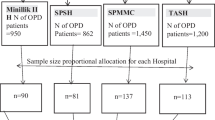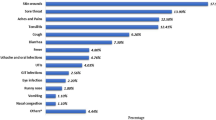Abstract
Objectives
This study was performed to assess self-medication with antibiotics (ATB) in the general population and its associated factors.
Methods
Face to face interviews using a structured questionnaire were conducted to collect data from ATB buyers in pharmacies in Beirut area. Data were analyzed using descriptive statistics and Chi-square test. A multivariate logistic regression was performed to predict self-medication.
Results
42 % of 319 participants were buying ATB without prescription and the pharmacists were the main helpers (18.8 %). Saving time was the most common cited reason for self-medication with ATB (39.7 %). The logistic regression showed that self-medication with ATB was significantly increased among men [OR = 3.03; IC 95 % (2–5)]; it was associated with sore throat symptoms [OR = 2.38; IC 95 % (1.40–4.03)] and the ignorance of ATB use dangers [OR = 3.33; IC 95 % (1.96–5.55)]. In addition, it was prominent with amoxicillin [OR = 1.93; IC 95 % (0.17–1.34)], and inversely related to quinolone [OR = 0.44; IC 95 % (0.18–1.03)] and cephalosporin families [OR = 0.28; IC 95 % (0.11–1.68)] or other ATB classes [OR = 0.96; IC 95 % (0.41–2.22)].
Conclusions
Self-medication with antibiotics is a relatively frequent problem in Beirut area. Interventions are required to reduce antibiotic misuse.

Similar content being viewed by others
References
Abasaeed A, Vlcek J, Mohammed M et al (2009) Self-medication with antibiotics by the community of Abu Dhabi Emirate, United Arab Emirates. J Infect Dev Ctries 3(7):491–497
Al-Bakri AG, Bustanji Y, Yousef AM (2005) Community consumption of antibacterial drugs within the Jordanian population: sources, patterns and appropriateness. Int J Antimicrob Agents 26:389–395
Andrajati R, Vlcek J, Haaijer-Ruskamp FM (2005) Prevalence a mozne rizikove factory rozvoje samoleceni antibiotiky v Ceske republice. Vnitr Lek 51(10):1096–1101
Avorn J, Solomon DH (2000) Cultural and economic factors that (mis)shape antibiotic use: the nonpharmacologic basis of therapeutics. Ann Intern Med 133(2):128–135
Barah F, Gonçlaves V (2010) Antibiotic use and knowledge in the community in Kalamoon, Syrian Arab Republic: a cross-sectional study. East Mediterr Health J 16(5):516–521
Barbosa TM, Levy SB (2000) The impact of antibiotic use on resistance development and persistence. Drug Resist Updates 3(5):303–311
Belongia EA, Naimi TS, Gale GM et al (2002) Antibiotic use and upper respiratory infections: a survey of knowledge, attitudes, and experience in Wisconsin and Minnesota. Prev Med 34:346–352
Borg M, Scicluna E, De Kraker M et al (2006) Antibiotic resistance in the south-eastern Mediterranean-preliminary results from the ARMed project. Euro Surveill 11:164–167
Byarugaba DK (2004) A view on antimicrobial resistance in developing countries and responsible risk factors. Int J Antimicrob Agents 24:105
Goossems H, Ferech M, Stichele RV, Elseviers M (2005) Outpatient antibiotic use in Europe and association with resistance: a cross sectional database study. Lancet 365(9459):579–587
Grigoryan L, Haaijer-Ruskamp FM, Burgerhof JGM et al (2006) Self-medication with antimicrobial drugs in Europe. Emerg Infect Dis 12:452–459
Grigoryan L, Burgerhof J, Degener J et al (2007) Attitudes, beliefs and knowledge concerning antibiotic use and self-medication: a comparative European study. Pharmacoepidemiol Drug Safety 16:1234–1243
Grigoryan L, Johannes B, John D, Reginald D et al (2008) Determinants of self-medication with antibiotics in Europe: the impact of beliefs, country wealth and the healthcare system. J Antimicrob Chemother 61(5):1172–1179
Levy SB (2005) Antibiotic resistance-the problem intensifies. Adv Drug Deliv Rev 57(10):1446–1450
Longman LP, Martin MV (1991) The use of antibiotics in the prevention of postoperative infection: a reappraisal. Br Dent J 170(7):257–262
Mitsi G, Jelastopulu E, Basiaris H, Skoutelis A, Gogos C (2005) Patterns of antibiotics use among adults and parents in the community: a questionnaire-based survey in a Greek urban population. Int J Antimicrob Agents 25(5):439–443
Nyazema N, Viberg N, Khoza S, Vyas S, Kumaranayake L, Tomson G et al (2007) Low sales of antibiotics without prescription: a cross-sectional study in Zimbabwean private pharmacies. J Antimicrob Chemother 59(4):718–726
Ordre des pharmaciens du Liban (1994) Loi numéro 367 relative à l'exercice de la profession de pharmacien. Liban, Aout 1994; titre IV:chapitre 2 (article 43). Available at: http://www.opl.org.lb/Legislations.php
Saradamma RD, Higginbotham N, Nichter M (2000) Social factors influencing the acquisition of antibiotics without prescription in Kerala State, south India. Soc Sci Med 50:891–903
Sawair FA, Baqain ZH, Abu Karaky A, Abu Eid R (2009) Assessment of self-medication of antibiotics in a Jordanian Population. Med Princ Pract 18:21–25
Sosa A, Byarugaba D, Amábile-Cuevas C, Hsueh P, Kariuki S, Okeke I (2010) Antimicrobial resistance in developing countries. New York; 554–559
Suleman S, Ketsela A, Mekonnen Z (2009) Assessment of self-medication practices in Assendabo town, Jimma zone, southwestern Ethiopia. Res Social Adm Pharm 5:76–81
World Health Organization (2000) Guidelines for the regulatory assessment of Medicinal Products for use in self-medication, 2000. WHO/EDM/QSM/00.1 http://apps.who.int/medicinedocs/pdf/s2218e/s2218e.pdf
World Health Organization (2002) Antimicrobial resistance. Fact sheet revised January; n:194. http://www.who.int/mediacentre/factsheets/fs194/en/
World Health Organization (2011) Antimicrobial resistance Fact sheet February; n:194. http://www.who.int/world-health-day/2011
Conflict of interest
The authors declare that they have no competing interests.
Author information
Authors and Affiliations
Corresponding author
Additional information
L. Cheaito and S. Azizi contributed equally to the manuscript and to the work.
Rights and permissions
About this article
Cite this article
Cheaito, L., Azizi, S., Saleh, N. et al. Assessment of self-medication in population buying antibiotics in pharmacies: a pilot study from Beirut and its suburbs. Int J Public Health 59, 319–327 (2014). https://doi.org/10.1007/s00038-013-0493-y
Received:
Revised:
Accepted:
Published:
Issue Date:
DOI: https://doi.org/10.1007/s00038-013-0493-y




